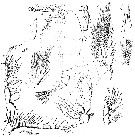|
|
 |
|
Calanoida ( Order ) |
|
|
|
Arietelloidea ( Superfamily ) |
|
|
|
Arietellidae ( Family ) |
|
|
|
Rhapidophorus ( Genus ) |
|
|
| |
Rhapidophorus wilsoni Edwards, 1891 (M) | |
| | | | | | | Ref.: | | | C.L. Edwards, 1891 (p.84, figs.?M); Giesbrecht, 1892 (p.423); Giesbrecht & Schmeil, 1898 (p.125); Fosshagen, 1968 a (p.61, Rem.); Ohtsuka & al., 1991 (p.801, Rem.) |  issued from : C.L. Edwards in Arch. Naturgesch., 1891, 57. [Taf.IV, Figs.1-11]. male (from Bahamas): 1, habitus (lateral); 2, A1; 2', seta annulated of proximal segment; 3, A2; 4, Md (mandibular blade); 5, Mx1 (lo = outer lobe; P = outer lobe; S = main ramus; X = outer ramus) ; 6, mx2; 7, Mxp; 7', portion of distal characteristic seta; 8, P1; 9, P2 to P4; 10, P5; 11, caudal ramus. Bp1 = basipodite 1; Re = exopodite; Ri = endopodite.
| | | | | NZ: | 1 | | |
|
Distribution map of Rhapidophorus wilsoni by geographical zones
|
| | | | Loc: | | | Bahamas (Abaco Is.) | | | | N: | 1 | | | | Lg.: | | | (305) M: 2,5; {M: 2,5} | | | | Rem.: | In the cavity of a holothurian: Mulleria (= Actinopyga) agassizii).
After Fosshagen (1968 a, p.61) the systematic position of this free-living copepod was uncertain at the origin. Giesbrecht (1892) assigned it to Centropagidae (sensu Giesbrecht) and Wilson (1932) invcluded it as a female in his key to the calanoid genera. Comparison of Edwards' figures of Rhapidophorus with Paramisophria shows that the two genera are closely related; it is very probable that the specimen was a male. The shape of the body, the long setae on the A2 and the mothparts, the short A1, the very similar A2, Mx2, Mxp, and swimming legs demonstrate the relationship between the two genera. Some reduction of the mandibular palpus has taken place in Paramisophria in the loss of the endopod. In Rhapidophorus, the palpus is supposed to be completely lacking. A more conspicuaous structural difference is found in Mx1; in Rhapidophorus the distal part is more powerfully developed and the endopod seems to be elongated and segmented. P5 of Rhapidophorus as figured is very similar to that of the left P5 of the male of Paramisophria ammophila and also possesses a rudimentary endopod.
Despite the incomplete description it seems that the genus Rhapidophorus ought to be referred to the Arietellidae. Whether Rhapidophorus and Paramisophria are synonymous (with the consequent priority of the former) cannot be decided until the female of Rhapidophorus has been described. | | | Last update : 29/04/2010 | |
|
|
 Any use of this site for a publication will be mentioned with the following reference : Any use of this site for a publication will be mentioned with the following reference :
Razouls C., Desreumaux N., Kouwenberg J. and de Bovée F., 2005-2025. - Biodiversity of Marine Planktonic Copepods (morphology, geographical distribution and biological data). Sorbonne University, CNRS. Available at http://copepodes.obs-banyuls.fr/en [Accessed November 30, 2025] © copyright 2005-2025 Sorbonne University, CNRS
|
|
 |
 |




